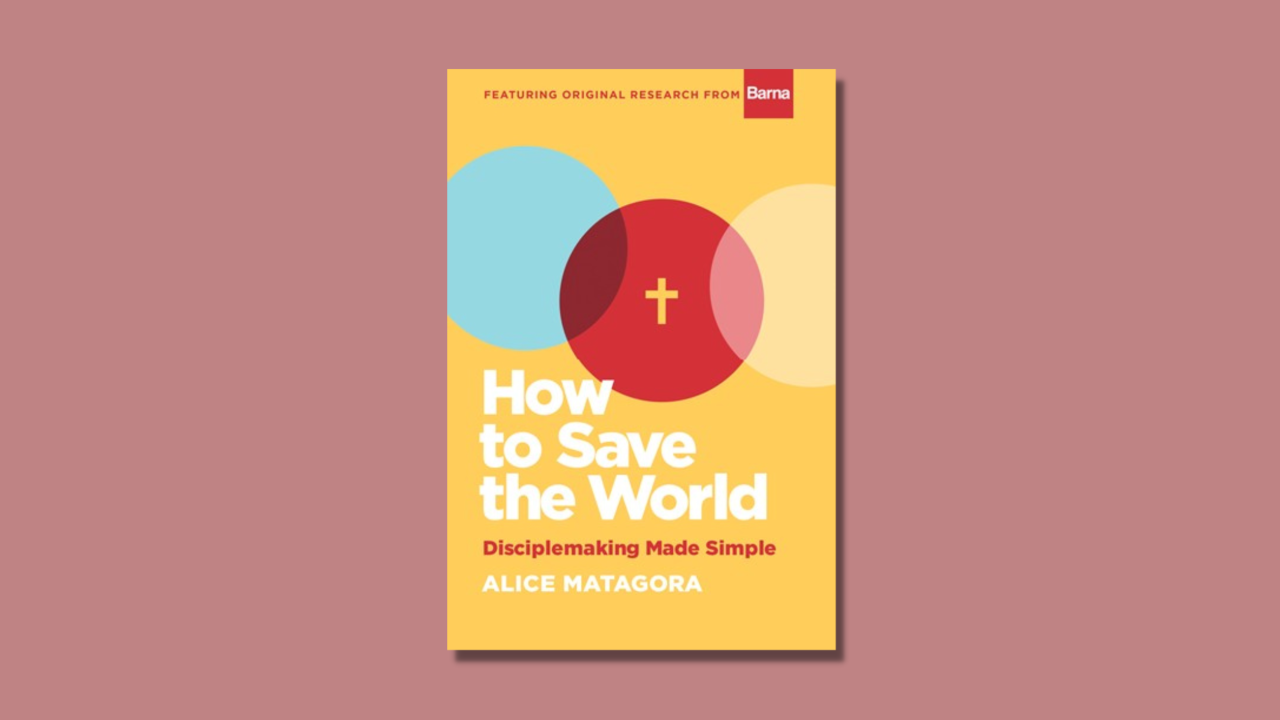How to Save the World
Does disciplemaking have to be difficult? In How to Save the World, Alice Matagora casts her vision for disciplemaking made simple.
Discipleship is Deeply Personal
The book begins by examining how Jesus made disciples. As the original disciplemaker, he revealed who God is and what his kingdom is about. He taught the disciples how to have a relationship with God. Matagora shows how discipleship is deeply personal. Jesus and his disciples lived life together amongst the lost. He equipped the disciples with all they needed to continue his disciple making work when he would leave. Yes, it would have been more efficient for Jesus to use miraculous means to make his disciples. Instead, Jesus calls his disciples to join him in the story in building the kingdom.
By looking at data from the Barna group, we see a variety of revealing statistics with relevant analysis by Matagora. While GenZ Christians report an interest in disciple making, older generations do not. This is a problem because disciple making relationships often involves someone more spiritually mature and typically older investing in someone who is younger. Key ingredients in a disciplemaker involve Jesus, the word, community, the lost, and spiritual generations. After each chapter are sections on every day disciplemaker case studies. They reveal that disciplemaking is unique, yet realistic.
Cultural Considerations in Disciplemaking
What was most meaningful to me was Matagora’s understanding of cultural considerations when it comes to disciple making. For instance, because Asian Hispanic and African cultures are generally more collectivistic, the importance of community is stressed. Minority group experiences in our country play a part in their collectivistic leanings. Matagora speaks of how she grew up as one of the few Asian Americans in a majority white area, and she speaks of the racism she survived with the help of her Chinese church.
I was most moved in Chapter 4 where Matagoria speaks openly and honestly about her eating disorder. During a season of depression and loneliness during her college years, she withdrew from school for a year and a half to receive professional medical treatment for anorexia nervosa. She entered into an unhealthy dating relationship and started spending more than what she made. She would transfer to UC Irvine as a sophomore, and it was here where she would find a relationship with Christ through the Navigators campus ministry.
Motivations for Making Disciples
Interestingly enough, Matagora was struck by how ordinary everyone was. They were simply Christians who loved the Bible. While she wasn’t discipled immediately, the discipleship culture would cause her to be around older, mature Christian women. She would eventually enter into a discipleship relationship with a woman named Jane, and she would learn how to read the Bible and pray. She would learn how to engage with God and walk with Jesus on her own. She finally felt free.
After struggling with infertility, Matagora became a mother when she was 37 years old. As a parent, she shares how she now better understands the motivations for disciplemaking. By looking at more data from Barna, she goes into detail about four qualities that are common to disciplemakers and their mindset: optimistic for change, accountability driven, relationally motivated, and growth minded. The study is revealing, and can help you as you challenge yourself as a disciple and disciple maker.
Barriers to Disciplemaking
I was most challenged when learning about the barriers to disciplemaking . These include a lack of resourcing, prioritizing disciplemaking among other responsibilities, not wanting to “make it weird,” and a lack of confidence in disciplemaking. Matagora challenges us to intentionality and investment. Specifically we should invest in people who are faithful, available, intentional, teachable, and have a heart for God and people. Creating a road-map for the discipling relationship as well as a follow-up plan would be helpful. Topics to cover include the gospel and the basics of the Christian life. More mature Christians can focus on the Great Commission and begin to teach the Bible to others.
The book ends with a question, asking if you would want to see what God would do. But this doesn’t happen overnight. Discipleship is for the long haul. This book does not make the discipleship process to be like that of a machine. Being vulnerable and open to brokenness is difficult. Identifying issues of the heart takes hard work. As a therapist, Matagora is quick to caution that disciplemaking is not the same as counseling and it is not meant to replace it. Discipling in relational conflicts, broken systems, and amongst the lost will take sensitivity. What I found most helpful was how Matagora speaks on disciplemaking across cultures and socioeconomic groups. She calls us to first understand our own cultural lenses, biases, and privileges and then to become students of those we are discipling. Jesus is Lord of all and is sufficient to meet all of our needs.
I received a media copy of How to Save the World and this is my honest review. Find more of my book reviews and follow Dive In, Dig Deep on Instagram - my account dedicated to Bibles and books to see the beauty of the Bible and the role of reading in the Christian life. To read all of my book reviews and to receive all of the free eBooks I find on the web, subscribe to my free newsletter.
